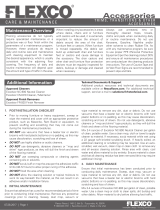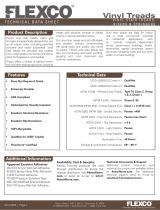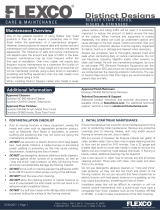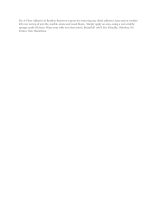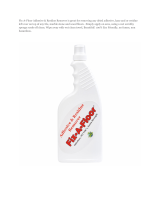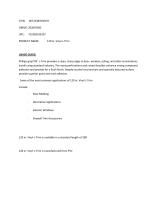Page is loading ...

Flexco Floors | 1401 E. 6th St. - Tuscumbia, AL 35674
P: 800.633.3151 | flexcofloors.com | Made in the USA
08.13.2017 | Page 1
TECHNICAL DATA SHEET
TRIMS, TRANSITIONS & OTHER
ACCESSORIES
Accessories
Flexco Accessories provide a wide
variety of vinyl trims, mouldings,
transitions, reducers, edge guards,
thresholds and adapters, in addition
to stair nosings, corner guards and
cove caps. Vinyl transitions are meant
to complement the wide variety of
flooring options that Flexco provides in
coordinating colors and thicknesses to
offer a complete product offering for all
flooring installations. Accessories offer
protection for flooring and walls, whether
for a transition between flooring surfaces
or for the protection of flash cove, wall
corners or stairs noses.
• Non-Porous Material
• Economical
• Extremely Durable
• ADA Compliant
Features
ASTM E84 - Surface Burning:
ASTM E648 (NFPA 253) - Critical Radiant Flux:
ASTM E662 (NFPA 258) - Smoke Density:
Acclimation Time:
Storage & Acclimation Temperature:
Class A
Class I, > 0.45 W/cm2
Passes, <450
48 Hours
65° - 85° F
Product Description
Technical Data
Approved Adhesives - Stair Nosings & Landing Trim
EN-610 Epoxy Nose Filler Adhesive
Approved Adhesives - All Other Accessories
EN-610 Epoxy Nose Filler Adhesive
C-630 Contact Adhesive
Approved Hard Setting Adhesive
Availability, Cost & Samples
Flexco products are sold through distribution. To locate the
nearest distributor, visit flexcofloors.com or send an e-mail to
info@flexcofloors.com.
Technical Documents & Support
Additional product resources and technical documents are
available online at flexcofloors.com. For additional technical
support, send an e-mail to solutions@rhctechnical.com.
Additional Information
1. PRE-INSTALLATION CHECKLIST
• Consult all associated product
literature concerning adhesive
installation, maintenance and
warranty prior to installation of
flooring.
• Allow all trades to complete work
prior to installation.
• Deliver all materials to the installation
location in its original packaging with
labels intact.
• Do not stack pallets to avoid damage.
• Remove any plastic and strapping
from product after delivery.
• Inspect all material for proper type,
color and matching lot numbers if
appropriate.
• Ensure that all adhesives intended for
installation are approved for use with
accessory material.
• Ensure installation area and material
storage temperatures are between
65° F (19° C) and 85° F (30° C) for
at least 48 hours before, during and
after installation.
• Ensure HVAC system is operational
and fully functioning at normal
operating conditions.
• Turn off radiant-heated flooring
systems 48 hours prior to installation.
48 hours after installation, gradually
increase the temperature over the
course of 24 hours to a maximum
temperature of 85°F (29.5° C).
• Protect installation area from extreme
temperature changes, such as heat
and freezing, as well as direct sunlight
for at least 48 hours before, during
and after installation.
• Do not proceed with installation until
all conditions have been met.
2. PRODUCT LIMITATIONS
Do not install accessory materials over
existing wall base, accessories, rubber,
vinyl or linoleum flash-cove, cork,
or asphaltic materials. Do not install
accessories in outdoor areas and in or
around commercial kitchens. Do not
install in areas that may be subjected
to sharp, pointed objects. Do not allow
product to be directly exposed to extreme
heat sources, such as radiators, ovens or
other high-heat equipment. Accessories
may be susceptible to staining from
harsh disinfectants, cleaning agents,
dyes or other harsh chemicals – ensure

08.13.2017 | Page 2
Flexco Floors | 1401 E. 6th St. - Tuscumbia, AL 35674
P: 800.633.3151 | flexcofloors.com | Made in the USA
TECHNICAL DATA SHEET
TRIMS, TRANSITIONS &
OTHER ACCESSORIES
Accessories
4. STAIR NOSING & LANDING
TRIM INSTALLATION
Prior to installation, confirm stair nosing
placement and the placement of adjoining
materials per design specifications.
Inspect all stair nosings prior to installation
to verify that there are no visible defects,
damages or excessive shading variations.
Some products, colors and textures have
latent and acceptable color and shade
variations. If there are concerns regarding
shade or color variation, do not install
material and consult sales representative
and manufacturer’s technical staff. Prior
to trimming stair nosings, any specified
Flexco Stringer or equivalent must be
installed (the inclusion of Flexco Stringers
is optional). Stair nosings which have
an undercut, underlap or flange must
be installed prior to the installation of
any adjoining flooring material or riser
material. Fit stair nosing to step and
mark material for trimming. Carefully trim
material along marked line using a razor
utility knife or a miter saw with a 60 tooth
or greater carbide tip blade. Confirm that
stair nosing fits tightly on step, ensuring
material is not over-compressed. Prior to
installation, clean the underside of the
stair nosing with a clean rag or towel and
denatured alcohol or equivalent solvent
adhesive remover. In areas which may be
exposed to excessive moisture or heavy
foot traffic, lightly sand the back of the
stair nosing to improve adhesion.
Apply a 1/4" - 1/2" bead of the EN-610
to the interior nose of the stair nosing.
All stair nosings must have the EN-610
installed in the stair nose. Failure to do
so may result in premature wear and
damage which could compromise egress
safety. Apply EN-610 to both surfaces of
the stair nosing and spread using a 1/8"
saw-tooth spreader. Be sure to achieve
75% adhesive coverage on both surfaces
of the nosing. Install nosing onto step
and roll material with a hand roller or
equivalent. Visually inspect installation to
ensure that material has not shifted and
that adhesive has not been squeezed out
of joints or compressed onto surface.
Avoid walking, kneeling or working on
material until adhesive has cured for light
foot traffic. Working on material that is
installed into wet adhesive could cause
adhesive to displace. When working
off of material is not possible, use a
kneeling board or equivalent to disperse
weight evenly and prevent adhesive
displacement.
To prevent movement, dust, dirt, debris
and topical moisture in or around seams,
tape seams together after installation
using a multi-purpose masking tape
intended for flooring and hard surfaces.
Pay close attention to open times to
avoid adhesion issues. This may require
installing material in smaller sections.
5. VERTICAL ACCESSORY
INSTALLATION
Prior to installation, ensure accessory
material has been properly acclimated and
that ambient conditions are within normal
operational ranges. Ensure substrate is
suitably prepared prior to installation,
as manufacturer is not responsible for
substrates that have not been properly
prepared. Ensure adhesive is approved
for use with accessory material and that
proper applicator type and size is used,
as manufacturer is not responsible for
any and all adhesion issues related to
improper adhesive selection or usage.
Accessories which have an undercut,
underlap or flange must be installed prior
to the installation of any adjoining flooring
material or wall base. When necessary,
carefully trim material using a razor utility
knife or a miter saw with a 60 tooth or
greater carbide tip blade. When installing
with a radius, ensure material can be
formed to accommodate radius prior to
installation and use the C-630 Contact
Adhesive to ensure that accessory will
stay in place. Some accessories may be
heated to achieve some radius'. If heating
an accessory to form a radius, confirm
material can accommodate radius prior to
permanently installing.
Apply adhesive to the back of the
accessory per adhesive instructions and
install accessory to substrate, ensuring
that accessory material is not stretched
or over-compressed during installation.
Stretching material or over-compressing
seams and corners may cause wall
base to shrink and/or curl/delaminate,
all chemicals and materials that may
come in contact with the accessories will
not stain, mar or otherwise damage the
material prior to use.
3. SUBSTRATE PREPARATION
All substrates must be clean, smooth,
permanently dry, flat, and structurally
sound. Substrates must be free of visible
water or condensation, dust, sealers,
water-based / acrylic paint, residual
adhesives and adhesive removers,
solvents, wax, oil, grease, asphalt,
gypsum compounds, visible alkaline
salts or excessive efflorescence, mold,
mildew and any other extraneous coating,
film, material or foreign matter. Vertical
substrates must be a structurally sound
interior wall surface, such as dry plaster,
cured drywall, fiber-reinforced plastic
(FRP) panels, fiberglass, exterior grade
plywood (Group 1, CC type), concrete,
metal and masonry. Any cracks, voids,
divots, grout lines and imperfections must
be filled with a cementitious patch (such
as the Excelsior CP-300) or filler suitable
for the substrate.
When installing directly over a resinous
products, such as an epoxy paint, ensure
that coating is dry to the touch and has
cured for the prescribed length of time.
Substrate must be clean, dry, sound
and free of contaminates. Material to be
installed over non-porous substrates, such
as epoxy paint, FRP panels or fiberglass,
must be installed with the Excelsior C-630
Contact Adhesive.
Metal substrates must be thoroughly
sanded/ground and cleaned of any
residue, oil, rust and/or oxidation.
Substrate must be smooth, flat and
sound prior to installation. When installing
in areas that may be subject to topical
water or moisture and/or high humidity,
an anti-corrosive coating must be applied
to protect metal substrate. Contact a
local paint or coating supplier for coating
recommendations. Install wall base
within 12 hours after sanding/grinding to
prevent re-oxidation. Metal substrates
are non-porous – follow all installation
instructions, trowel sizes and flash times
for non-porous substrates.

08.13.2017 | Page 3
Flexco Floors | 1401 E. 6th St. - Tuscumbia, AL 35674
P: 800.633.3151 | flexcofloors.com | Made in the USA
TECHNICAL DATA SHEET
TRIMS, TRANSITIONS &
OTHER ACCESSORIES
Accessories
When installing accessory alone, cut
accessory to desired length, when
necessary and apply adhesive directly to
the back of the accessory per adhesive
instructions. Install accessory to substrate,
ensuring that accessory material is not
stretched or over-compressed during
installation. Stretching material or over-
compressing seams and corners may
cause accessory to shrink and/or curl/
delaminate, respectively.
When installing accessory in conjunction
with flooring material, cut material to
desired length. Ensure that adhesive
for the floor covering is compatible with
the adhesive for the accessory material.
Ensure adhesive open times are met and
that foot traffic limits are observed.
Periodically lift material to ensure proper
adhesive transfer - adhesive should cover
90% of accessory. Using a suitable hand
roller, carefully roll material in the direction
of the last piece installed with a hand
roller within 30 minutes of installation.
7. INITIAL MAINTENANCE
Ensure that adhesive has cured for
recommended period of time prior to
conducting initial maintenance. Remove
any protective coverings prior to cleaning.
Sweep, dust or wipe material to remove
any dirt, dust or debris. DO NOT use
vacuums or electric brooms which
have beater bars, hard plastic bottoms,
a rubber bumper or are lacking proper
padding or protection, as this may cause
marking, discoloration, scratching and
loss of sheen. Do not use detergents,
abrasive cleaners or “mop and shine”
type products, as they will dull the finish
and sheen of the material.
Mix 2-4 ounces of Excelsior NC-900
Neutral Cleaner per gallon of clean, potable
water. Use a clean towel or cloth to apply
cleaner to material. If heavily soiled, an
additional cleaning may be required. Use
clean towel or cloth to remove any and all
excess cleaning solution. Rinse area with
clean, cool water and allow material to dry
entirely. Ensure material is clean and that
all all cleaning residue has been removed
(this may require additional rinsing).
For further information regarding daily
or routine maintenance, please consult
the product care & maintenance
document or the associated product
technical data sheet.
8. FLOORING & MATERIAL
PROTECTION
Protect newly installed flooring and
accessories with construction grade
paper or protective boards, such as
Masonite or Ram Board, to prevent
damage by other trades. Do not slide or
drag pallets or heavy equipment across
the new accessories. Limit usage and
foot traffic according to the adhesive's
requirements. When moving appliances
or heavy furniture, protect flooring and
accessories from scuffing and tearing
using temporary floor protection.
All furniture casters must be made of a
soft material and must have a contact
point of at least 1” in width to limit
indentation and flooring or accessory
damage. All rolling chairs or seating must
have a resilient flooring chair pad installed
over the finished floor to protect floor
covering. All fixed furniture legs must
have permanent felt or soft rubber floor
protectors installed on all contact points
to reduce indentation. Floor protectors
must have a flat contact point of at least 1"
in width and must cover the entire bottom
surface of the furniture leg.
Ensure all furniture castors and chair
legs and are clean and free of any and
all dirt and debris. Routinely clean chair
castors and furniture legs to ensure that
dirt or debris has not built up or become
embedded in castors or floor protectors.
Replace chair castors and floor protectors
at regular intervals, especially if they
become damaged or heavily soiled.
Place walk-off mats at outside entrances.
Ensure mats are manufactured with non-
staining backs to prevent discoloration.
9. WARRANTY
Flexco provides a 1 year limited warranty
for all Accessories wall base. For additional
information, see associated warranty
documents.
respectively.
Periodically lift material to ensure proper
adhesive transfer - adhesive should cover
90% of accessory. Using a suitable hand
roller, carefully roll material in the direction
of the last piece installed with a hand
roller within 30 minutes of installation.
Vinyl accessory installations can be
enhanced by using Flexco’s matching
Colored Caulk to fill any voids or
imperfections. Allow accessory to cure
for the required period of time and do not
disturb until curing time is complete.
6. HORIZONTAL ACCESSORY
INSTALLATION
Ensure substrate is suitably prepared
prior to installation, as manufacturer is
not responsible for substrates that have
not been properly prepared and tested for
moisture. When using the C-630 Contact
Adhesive, be sure to a clean dusty and/
or cementitious substrates with a damp
mop or sponge prior to installation to
remove dust, dirt and debris.
Ensure adhesive is approved for use with
accessory material and that proper trowel
type and size is used, as manufacturer is
not responsible for any and all adhesion
issues related to improper adhesive
selection or usage. When installing
in conjunction with adjacent flooring
materials and adhesive, be sure adhesive
is a hard-setting adhesive (not a pressure
sensitive) and observe adhesive open
times to avoid adhesion issues.
Accessories which have an undercut,
underlap or flange must be installed
prior to the installation of any adjoining
flooring material. When necessary,
carefully trim material using a razor utility
knife or a miter saw with a 60 tooth or
greater carbide tip blade. When installing
with a radius, ensure material can be
formed to accommodate radius prior to
installation and use the C-630 Contact
Adhesive to ensure that accessory will
stay in place. Some accessories may be
heated to achieve some radius'. If heating
an accessory to form a radius, confirm
material can accommodate radius prior to
permanently installing.
FOR PROFESSIONAL USE ONLY. PLEASE CONSULT ALL ASSOCIATED TECHNICAL DATA SHEETS, SAFETY
DATA SHEETS, MAINTENANCE DOCUMENTS AND WARRANTY INFORMATION PRIOR TO INSTALLATION.
/
